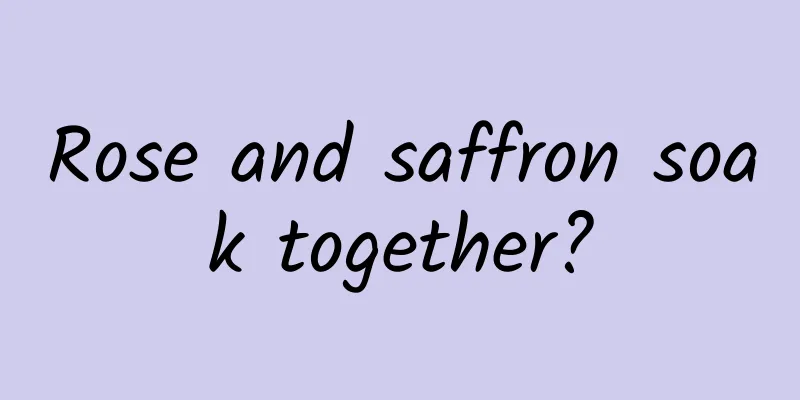Rose and saffron soak together?

|
Rose is a flower with extremely high ornamental value. Rose is not only very beautiful and loved by many women, but also has extremely high nutritional value in terms of food and medicine. Many people like to use dried roses to make tea and drink it as rose tea. Saffron is a precious and rare medicinal material that many people have heard of. So can roses and saffron be used together to make tea? Saffron and rose can be soaked in water together to drink. Saffron can be soaked in water together to drink. Saffron is sweet and flat in nature, and has the effects of promoting blood circulation, removing blood stasis, nourishing blood, relieving depression and calming the mind. Rose flowers are sweet, slightly bitter, and warm in nature. They can promote qi and relieve depression, regulate blood circulation and relieve pain. Saffron and rose have no obvious toxic side effects and no conflict in medicinal properties, so saffron and rose can be soaked together. However, saffron has all the benefits of rose, and its benefits are better and more comprehensive, so it is generally recommended to soak saffron alone. What are the benefits of soaking saffron and rose together? Saffron has a strong effect of promoting blood circulation and removing blood stasis, and can dredge blood vessels and maintain blood vessel patency; rose can enter the blood, has the effect of harmonizing blood, dispersing blood stasis and relieving pain. The two are used together, which is helpful for menstrual bleeding caused by blood stasis, amenorrhea, dysmenorrhea, oligomenorrhea and other symptoms. Traditional Chinese medicine believes that saffron can beautify the skin, cool the blood and detoxify; rose can replenish blood and promote qi circulation, beautify the skin. Using both together can promote blood circulation, regulate qi and blood, and regulate the body's endocrine levels. It is very helpful for women with skin problems such as spots, dull skin, and wrinkles. Help sleep Saffron can relieve depression and soothe the mind, rose can promote qi and relieve depression. Drinking them together in water can help relieve depression and mental fatigue, relax the body and mind, and help improve sleep quality. For people with sleep disorders, taking saffron and rose in water has certain benefits. Which is better, saffron or rose? Both saffron and rose have the effect of promoting blood circulation, and are helpful for menstrual disorders caused by blood stasis. Because saffron has a strong blood-activating effect, it is often used to treat amenorrhea, postpartum lochia, and pain caused by blood stasis. Rose is good at soothing the liver, regulating qi and relieving depression, and is often used to treat liver qi stagnation, liver-stomach disharmony, abdominal distension and pain, and flank pain. In terms of efficacy, saffron has all the efficacy of rose, and the efficacy of saffron is better and more comprehensive. In this respect, saffron is better. But saffron is expensive, far more expensive than roses. If you are more sensitive to price, you can choose roses. What should you pay attention to when taking saffron? 1. Dosage: If saffron is taken in water, generally 5-8 filaments are enough. Due to the strong physiological activity of saffron, the dosage should not exceed 10 grams, otherwise it may cause poisoning reactions, such as abdominal pain, diarrhea, or even unconsciousness, fainting, etc. 2. Time of taking saffron: It is not suitable to take it every day. It has a stimulating effect on nerves and blood vessels. Taking it every day may easily lead to getting angry. It is generally recommended to stop taking it for 1 day after taking it for 3-4 days, or take it every other day. 3. Pregnant women are forbidden to take saffron because saffron can stimulate the smooth muscle of the uterus and cause the uterus to contract, which may cause abdominal pain or even miscarriage in pregnant women. 4. Women during menstruation should not take saffron. Taking saffron during menstruation may cause increased menstrual blood volume or prolonged menstrual period. 5. People with gastrointestinal ulcers or bleeding should not take saffron because it has a strong blood-activating effect, which may cause gastrointestinal ulcers to rupture or increase bleeding or even cause massive bleeding. 6. People who are allergic to pollen: Saffron contains a small amount of pollen. People who are allergic to pollen should not take it to avoid allergic reactions. What should you pay attention to when taking roses? 1. The recommended dosage of roses is 3-6 grams. Roses are warm in nature, and taking too much may cause symptoms such as getting angry. 2. It is not advisable to take roses every day. Roses have the effect of promoting blood circulation and qi movement. Taking them every day may cause the blood circulation in the body to accelerate, which may cause an increase in menstrual blood volume. 3. Women with heavy menstrual flow should not take rose tea. Rose tea can promote blood circulation and relieve blood stasis. Women with heavy menstrual flow may take it because it may increase menstrual blood volume and even cause heavy bleeding. Even women with light menstrual flow are not recommended to take rose tea during menstruation. It is recommended to consult a doctor and determine the drug combination and dosage under the doctor's guidance. 4. Pregnant women can take roses to promote blood circulation, relieve blood stasis and promote qi circulation. Pregnant women should not take roses to avoid abdominal discomfort or even miscarriage. 5. Patients with constipation should not take rose flowers. Rose flowers are sweet and warm in nature and have astringent effects. Taking rose flowers may aggravate constipation symptoms. 6. People with weak constitution should not take roses. Roses are warm in nature, can promote qi and disperse. Taking them by people with weak constitution may aggravate the symptoms of qi deficiency and make their constitution even weaker. |
<<: The efficacy and function of washing face with mugwort leaves
>>: What are the effects and functions of the traditional Chinese medicine Baiwei?
Recommend
Is the dandelion powder from the drugstore good?
I believe everyone has seen dandelions and they a...
Why did the Iron Dome anti-missile system, which was once like a god, fail to stop the Kassan rocket?
Since 2012, the armed conflicts between Palestine...
The urine of a 26-year-old programmer actually attracted a group of ants! When the body sends these signals, you should be careful
Recently, such a piece of news has attracted peop...
Both patients who received pig heart transplants died. Is it a "killer pig heart" or a life-saving straw?
Another attempt by mankind to explore xenotranspl...
The efficacy and function of night primrose
Night-blooming jasmine is one of the common tradi...
The efficacy and function of Polygonum japonicum
Polygonum japonicum is a kind of traditional Chin...
The efficacy and function of moray eel
Moray eel is a kind of Chinese herbal medicine. W...
The efficacy and function of summer solstice grass
Friends who don’t know about summer solstice gras...
Why can't a broken glass be restored?
In daily life, sometimes we accidentally break a ...
The efficacy and function of egg leaf parasitism
Do you know about the egg leaf parasite? It is a ...
For the first time in more than 40 years! A new species called "Beijing" appeared in Chaobai River. Who is it?
In January this year, a research team from the In...
Washing dishes this way increases bacteria by 70 times! All of them are eaten by the stomach...
In daily life Many people have this habit at home...
How terrible is the only insect that can live in Antarctica?
Compared to the Arctic, Antarctica is much more d...
The efficacy and function of Tibetan peach leaf coral fruit
As people's research on traditional Chinese m...
The young man did not eat seafood or drink beer, but he got gout! It turns out that soda can also increase uric acid
Daqin, 28 years old, likes to drink beer and eat ...









